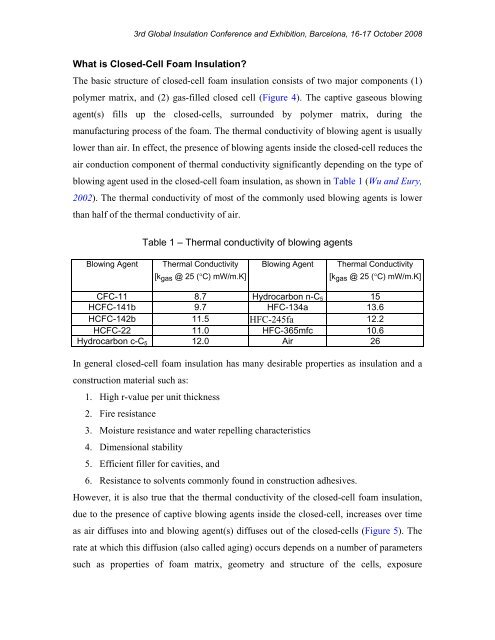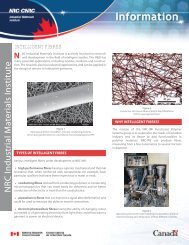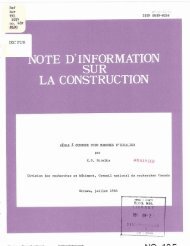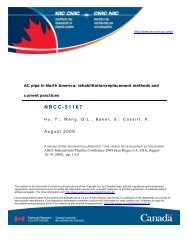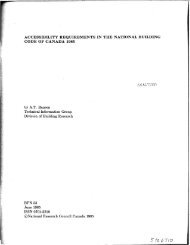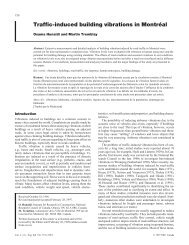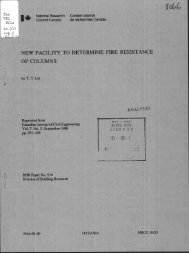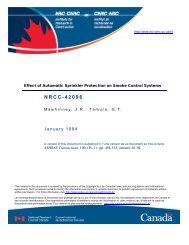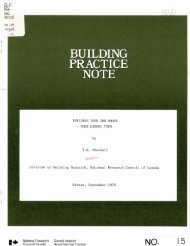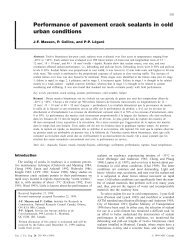Long-Term Thermal Resistance of Closed-Cell Foam Insulation ...
Long-Term Thermal Resistance of Closed-Cell Foam Insulation ...
Long-Term Thermal Resistance of Closed-Cell Foam Insulation ...
- No tags were found...
You also want an ePaper? Increase the reach of your titles
YUMPU automatically turns print PDFs into web optimized ePapers that Google loves.
3rd Global <strong>Insulation</strong> Conference and Exhibition, Barcelona, 16-17 October 2008What is <strong>Closed</strong>-<strong>Cell</strong> <strong>Foam</strong> <strong>Insulation</strong>?The basic structure <strong>of</strong> closed-cell foam insulation consists <strong>of</strong> two major components (1)polymer matrix, and (2) gas-filled closed cell (Figure 4). The captive gaseous blowingagent(s) fills up the closed-cells, surrounded by polymer matrix, during themanufacturing process <strong>of</strong> the foam. The thermal conductivity <strong>of</strong> blowing agent is usuallylower than air. In effect, the presence <strong>of</strong> blowing agents inside the closed-cell reduces theair conduction component <strong>of</strong> thermal conductivity significantly depending on the type <strong>of</strong>blowing agent used in the closed-cell foam insulation, as shown in Table 1 (Wu and Eury,2002). The thermal conductivity <strong>of</strong> most <strong>of</strong> the commonly used blowing agents is lowerthan half <strong>of</strong> the thermal conductivity <strong>of</strong> air.Table 1 – <strong>Thermal</strong> conductivity <strong>of</strong> blowing agentsBlowing Agent<strong>Thermal</strong> ConductivityBlowing Agent<strong>Thermal</strong> Conductivity[k gas @ 25 (°C) mW/m.K][k gas @ 25 (°C) mW/m.K]CFC-11 8.7 Hydrocarbon n-C 5 15HCFC-141b 9.7 HFC-134a 13.6HCFC-142b 11.5 HFC-245fa 12.2HCFC-22 11.0 HFC-365mfc 10.6Hydrocarbon c-C 5 12.0 Air 26In general closed-cell foam insulation has many desirable properties as insulation and aconstruction material such as:1. High r-value per unit thickness2. Fire resistance3. Moisture resistance and water repelling characteristics4. Dimensional stability5. Efficient filler for cavities, and6. <strong>Resistance</strong> to solvents commonly found in construction adhesives.However, it is also true that the thermal conductivity <strong>of</strong> the closed-cell foam insulation,due to the presence <strong>of</strong> captive blowing agents inside the closed-cell, increases over timeas air diffuses into and blowing agent(s) diffuses out <strong>of</strong> the closed-cells (Figure 5). Therate at which this diffusion (also called aging) occurs depends on a number <strong>of</strong> parameterssuch as properties <strong>of</strong> foam matrix, geometry and structure <strong>of</strong> the cells, exposure


